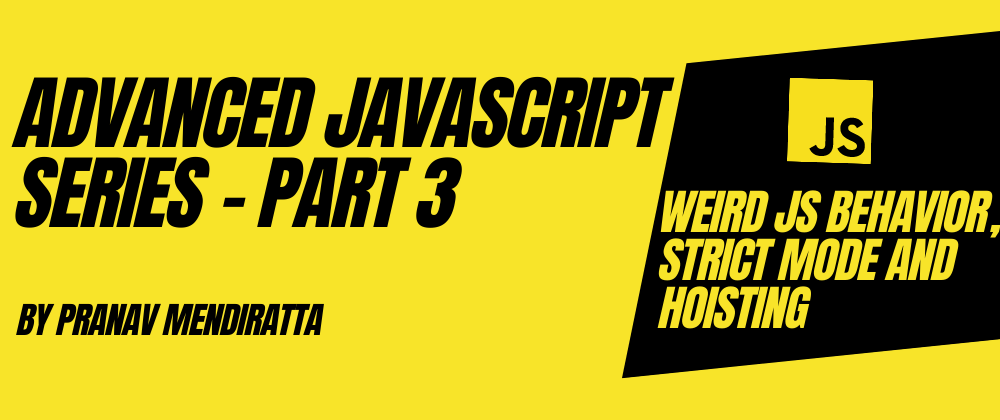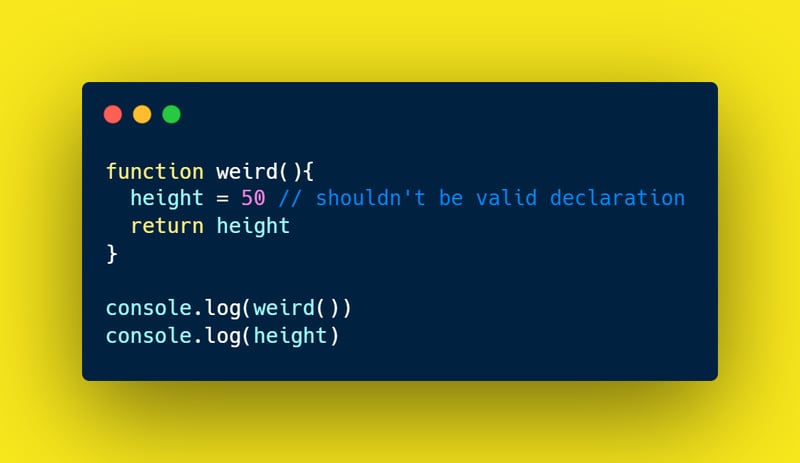Weird JS Behavior
Code-
Output-
50
50
In the code sample, we didn't even explicitly declare the variable but we are able to use without any error and it is available in global scope
Explanation-
- Older versions of JS allowed us to create variables without explicitly declaring them using the
var,letor theconstkeyword. - There are a lot of downfalls to this, some of them being-
Downfalls-
- JS creates these variables in global scope by default thus anyone can access them from outside the function and change them.
- You can mistype a variable name and JS won't even give an error, instead it will create a new variable in the global scope because of this behavior.
Solution: Strict Mode
Introduction-
- The "use strict" directive was new in ECMAScript version 5 indicating use of strict mode while running the code.
- It is supported by all the modern browsers and since it is only a string, even older versions that don't understand it won't throw any error.
- It prevents all the bad code practices in previous JS versions from turning into actual errors.
- If declared at the beginning of a script, it has global scope whereas if it is used inside the function then it's scope is only for that block/block scope.
Declaration example-
"use strict";
x = 3.14; // this will cause error
Issues that "use strict" fixes-
- If you mistakenly mistype a variable, if ran in strict mode, it will throw an error instead of creating a new global variable.
- It prevents us from assigning values to non-writable properties by throwing an error. This wasn't the same in previous versions.
- Keywords reserved for future JavaScript versions can not be used as variable names in strict mode.
- Prevents us from duplicating parameter names.
- Prevents us from writing to a read-only properties.
- Prevents us from writing to a get-only property.
"use strict";
const obj = {get x() {return 0} };
obj.x = 3.14; // This will cause an error
7.Prevents us from deleting an undeletable property.
"use strict";
delete Object.prototype; // This will cause an error
8.Prevents us from using Octal numerical literals and Octal escape characters. Example-
"use strict";
let x = 010; // gives error
let x = "\010"; // gives error
- Check this article for all the things that are not allowed in "use strict".
Note- The "use strict" directive is only recognized at the beginning of a script or a function.
Hoisting-
- Hoisting is JavaScript's default behavior of moving all the declarations at the top of the scope before code execution.
- It could be variable declarations or function declarations or even class declarations.
 Credits-tutorialsteacher
Credits-tutorialsteacher
Example of variable hoisting-
Code-
x = 5 // doesn't give any error because of hoisting
console.log(x)
var x // this gets hoisted to the top of the scope
Output-
5
Example of function hoisting-
Code-
console.log(hello()) // doesn't give any error because of hoisting
function hello(){ // this gets hoisted to the top of the scope
return "hello world"
}
Output-
"hello world"
- Variables declared with
letandconstare also hoisted but, unlikevar, are not initialized with a default value such asundefined. AReferenceErrorexception will be thrown if a variable declared withletorconstis read before it is initialized. This is because they stay in a Temporal Dead Zone before they are explicitly declared. We will learn more about Temporal Dead Zone ahead.
Code-
console.log(x)
let x
x = 5
Output-
Uncaught ReferenceError: Cannot access 'x' before initialization
Code-
console.log(x)
const x = 5
Output-
Uncaught ReferenceError: Cannot access 'x' before initialization
All JavaScript declarations are hoisted but not for initialization. Initialization in variables using
varkeyword are partially hoisted but those usingletorconstkeyword are not hoisted at all and give error.Partial hoisting means that the JS engine before running the code line by line already knows that the variable exists and has some memory allocated (because of hoisting) but the value for it hasn't been set/ stored yet (it gets set when we actually reach that line of code) thus a default value of
undefinedis set and returned. This partial hoisting happens in case of variable initialization usingvarkeyword.

Credits- Sabih Rehman
Example 1
Code-
console.log(x)
var x = 5 // this is initialization, not a declaration
Output-
undefined
This code does not work because initializations are not hoisted. It returns undefined because we have used var here that leads to partial hoisting as discussed above.
Example 2
Code-
console.log(x)
let x = 5 // this is initialization, not a declaration
Output-
Uncaught ReferenceError: Cannot access 'x' before initialization"
This is because variable initialization using let or const don't get hoisted.
Temporal Dead Zone-
The variables declared using
letandconstare not accessible before they are initialized with some value, and the phase between the starting of the execution of block in which the variable is declared usingletorconsttill that variable is being initialized is called Temporal Dead Zone for the variable.
- Accessing the variable before the initialization results in a ReferenceError.
Code-
console.log(x)
let x
x = 5
Output-
Uncaught ReferenceError: Cannot access 'x' before initialization
The term "temporal" is used because the zone depends on the order of execution (time) rather than the order in which the code is written (position). For example, the code below works because, even though the function that uses the
letvariable appears before the variable is declared, the function is called outside the TDZ.
Code-
{
// TDZ starts at beginning of scope
const func = () => console.log(letVar); // OK
// Within the TDZ letVar access throws `ReferenceError`
let letVar = 3; // End of TDZ (for letVar)
func(); // Called outside TDZ!
}
Output-
3
Temporal Dead Zone tricky example-
function test(){
var foo = 33;
if(foo) {
let foo = (foo + 55); // ReferenceError
}
}
test();
The
ifblock is evaluated because the outervar foohas a value. However due to lexical scoping this value is not available inside the block: the identifierfooinside theifblock is thelet foo. The expression(foo + 55)throws aReferenceErrorbecause initialization oflet foohas not completed — it is still in the temporal dead zone.
Connect with me-
Appendix-
- Advanced JavaScript Series - Part 1: Behind the scenes (JavaScript Engine, ATS, Hidden Classes, Garbage Collection)
- Advanced JavaScript Series - Part 2: Execution Context and Call Stack
- Advanced JavaScript Series - Part 3: Weird JS behavior, Strict Mode and Hoisting, Temporal Dead Zone
- Advanced JavaScript Series - Part 4.1: Global, Function and Block Scope, Lexical vs Dynamic Scoping
- Advanced JavaScript Series - Part 4.2: Scope Chains and their working, Lexical and Variable Environments
- Advanced JavaScript Series - Part 5: IIFE & 'this' keyword in JS(tricky Eg.), call(), apply(), bind(), Currying(Functional Prog)
- Advanced JavaScript Series - Part 6.1: Everything in JS is an Object? Weird JS behaviors revealed, Primitive Non-Primitive Types
- Advanced JavaScript Series - Part 6.2: Pass by Value & Pass by Reference, Shallow & Deep Copy, Type Coercion
- Advanced JavaScript Series - Part 7: First Class Citizens & Higher Order Functions
- Advanced JavaScript Series - Part 8: The 2 Pillars~ Closures & Prototypal Inheritance
- Advanced JavaScript Series - Part 9: Constructor Functions, Object Oriented,
newkeyword
References-
- https://www.w3schools.com/js/js_strict.asp
- https://www.w3schools.com/js/js_hoisting.asp
- https://developer.mozilla.org/en-US/docs/Glossary/Hoisting
- https://developer.mozilla.org/en-US/docs/Web/JavaScript/Reference/Statements/const
- https://www.geeksforgeeks.org/what-is-the-temporal-dead-zone-in-es6/#:~:text=The%20let%20and%20const%20variables,Dead%20Zone%20for%20the%20variable.
- https://developer.mozilla.org/en-US/docs/Web/JavaScript/Reference/Statements/let
All codes implemented using JS Fiddle








Top comments (0)